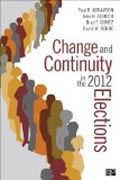
Change and Continuity in the 2012 Elections
Abramson, Paul R.
Aldrich, John H
Gomez, Brad T.
Rohde, David W.
Since its first edition in 1980, Change and Continuity has been known for offering the best analysis and explanation of voting behaviour in the most recent US elections while setting those results in the context of larger trends and patterns in elections studies. Adopters appreciate how this top-notch author team meticulously explains to undergraduates the import and impact of their analysis of the NES data. The 2012 edition, with its current scholarship and its excellent use and display of data, covers the most recent presidential and Congressional elections, voter turnout, and the social forces, party loyalties, and prominent issues that affect voting behaviour. INDICE: IntroductionChapter 1: The Nomination Struggle Who Ran The Rules of the Nomination System The Dynamics of Multicandidate CampaignsChapter 2: The General Election Campaign The Strategic Context and Candidates’ Choices Political Context, Overall Strategy, and Opening Moves From the Conventions to the Debates The End Game and the Struggle Over Turnout Did the Campaign Make a Difference?Chapter 3: The Election Results The Election Rules The Pattern of Results State-by-State Results Electoral Change in the Postwar South The Electoral Vote BalanceChapter 4: Who Voted? Voter Turnout, 1789–1916 Voter Turnout, 1920–2012 Voter Turnout among Social Groups Changes in Turnout After 1960 Election-Specific Factors Does Low Voter Turnout Matter?Chapter 5: Social Forces and the Vote How Social Groups Voted in 2012 How Social Groups Voted during the Postwar Years Why the New Deal Coalition Broke DownChapter 6: Candidates, Issues, and the Vote Attitudes toward the Candidates Prospective Evaluations Issue Positions and Perceptions Issue Voting Criteria Apparent Issue Voting in 2012 ConclusionChapter 7: Presidential Performance and Candidate Choice What Is Retrospective Voting? Evaluations of Government Performance on Important Problems Economic Evaluations and the Vote for the Incumbent Foreign Policy Evaluations and the Vote for the Incumbent Evaluations of the Incumbent The Impact of Retrospective Evaluations ConclusionChapter 8: Party Loyalties, Policy Preferences, and the Vote Party Identification: The Original View Party Identification: An Alternative View Party Identification in the Electorate Hispanic Partisanship in 2008 and 2012 Party Identification and the Vote Policy Preferences and Performance Evaluations ConclusionChapter 9: Candidates and Outcomes in 2012 Election Outcomes in 2012 Candidates’ Resources and Election Outcomes The 2012 Elections: The Impact on Congress The 2014 Elections and BeyondChapter 10: The Congressional Electorate in 2012 Social Forces and the Congressional Vote Issues and the Congressional Vote Party Identification and the Congressional Vote Incumbency and the Congressional Vote The Congressional Vote as Referendum Presidential Coattails and the Congressional Vote ConclusionChapter 11: The 2012 Elections and the Future of American Politics The Great Continuities: The Electoral System and the Party System The Great Change: Depolarization and the Return of Partisan Polarization Change and Continuity in Turnout Continuities in Electoral Partisanship Changes in the Partisan Electorate Change and Continuity in the U.S. Congress
- ISBN: 978-1-4522-4045-9
- Editorial: CQ Press
- Encuadernacion: Rústica
- Páginas: 408
- Fecha Publicación: 30/06/2014
- Nº Volúmenes: 1
- Idioma:
